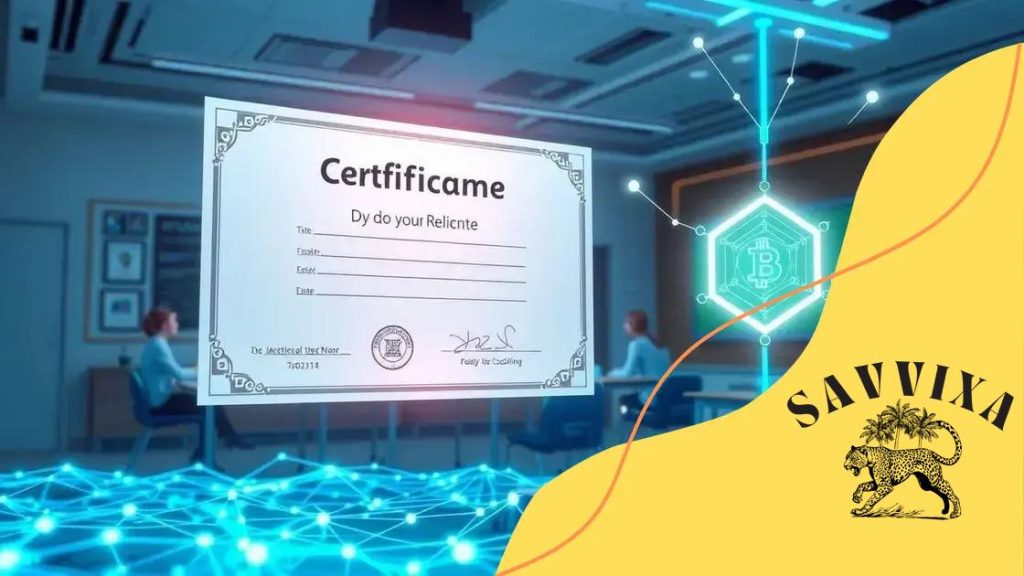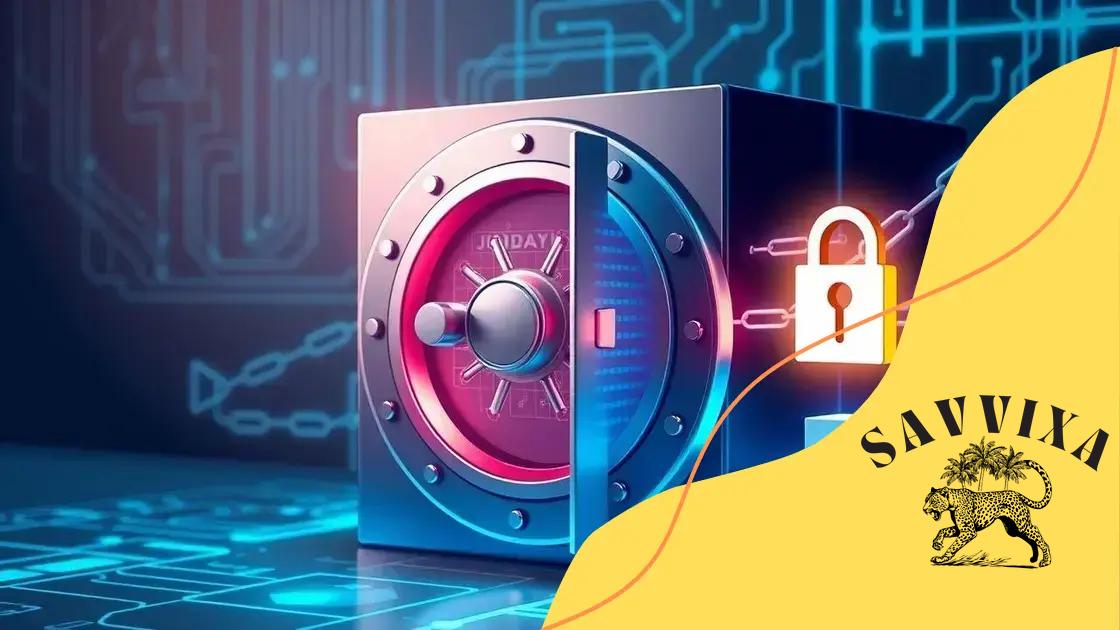Blockchain for secure academic records: why it matters

Blockchain technology enhances secure academic records by providing tamper-proof verification, decentralization, and improved transparency, significantly reducing fraud and streamlining administrative processes in educational institutions.
Blockchain for secure academic records is becoming increasingly important in the fast-evolving educational landscape. Have you ever wondered how this technology could transform record-keeping and enhance trust? Let’s dive into its potential.
Understanding blockchain technology
To understand how blockchain technology works, we must begin with its basic principles. Blockchain is a digital ledger that records transactions across many computers in a way that the recorded transactions cannot be altered retroactively. This technology ensures security, transparency, and trust among participants.
At the core of blockchain is a chain of blocks that contain data. Each block includes a specific number of transactions and a unique code called a “hash.” This hash connects the block to the previous one, creating a secure chain. The decentralization feature of blockchain means that these records are not held in one single location but rather across a network of computers, making it difficult for anyone to manipulate the data.
Key Features of Blockchain Technology
- Decentralization: No single entity controls the blockchain, enhancing security.
- Transparency: All participants can view the transactions, fostering trust.
- Security: Cryptography ensures that the data remains secure and unchangeable.
- Immutability: Once recorded, the data in a block cannot be altered, ensuring its integrity.
These features are what make blockchain so valuable, especially in fields like finance and education. For instance, when used for academic records, it eliminates fraud and ensures that credentials are verified instantly.
As we move forward, the applications of blockchain technology continue to expand beyond cryptocurrencies and financial transactions. Industries like supply chain management, healthcare, and even voting systems are exploring its benefits. The potential for blockchain to revolutionize how we handle data is enormous.
How Blockchain Works
Every transaction on the blockchain is verified by a process called consensus. This means that before a new block is added, multiple participants need to agree that the information is correct. Once agreed upon, the transaction is recorded on a block and added to the chain. This verification adds another layer of security while maintaining trust among users.
In summary, understanding blockchain technology is crucial in today’s digital age. As more sectors begin to harness its advantages, staying informed about how it functions will be essential for anyone involved in these industries.
Benefits of using blockchain in education
The benefits of using blockchain in education are becoming increasingly clear as institutions begin to adopt this innovative technology. By leveraging blockchain, educational institutions can enhance transparency, improve security, and streamline administrative processes.
One of the primary advantages is the ability to maintain secure and verifiable academic records. Traditional methods often involve lengthy verification processes that can cause delays. With blockchain, records are stored in a decentralized manner, allowing for quick and easy access for students, employers, and institutions alike.
Key Advantages of Blockchain in Education
- Improved security: Sensitive information is encrypted and stored across a network, reducing the risk of data breaches.
- Verification of credentials: Employers can quickly verify a candidate’s qualifications through immutable records.
- Cost-effectiveness: By reducing administrative overhead, institutions can redirect funds to improve educational resources.
- Student empowerment: Learners can have ownership of their records, deciding how and when to share them.
Moreover, the use of blockchain technology can help combat issues like fraud in degree certificates. Traditional paper-based certificates can be forged, leading to lost trust in institutions. However, with blockchain, each certificate is unique, tamper-proof, and easily verifiable. This capability bolsters the credibility of educational programs.
An additional benefit is the enhancement of collaborative learning. Blockchain can facilitate connections between students and institutions, providing a platform for sharing knowledge and resources seamlessly. This type of accessibility can foster a more inclusive learning environment.
The Future of Education with Blockchain
The future looks promising for blockchain in education. As technology evolves, we can expect more innovative applications, such as personalized learning pathways and decentralized funding for student projects. The synergy between education and blockchain has the potential to reshape how we perceive credentials and learning.
How blockchain enhances data security

Understanding how blockchain enhances data security is crucial in our digital world. Blockchain technology offers a unique approach to securing data, ensuring that information remains tamper-proof and easily verifiable.
At its core, blockchain operates as a decentralized ledger, meaning that it does not rely on a single point of control. Each transaction is recorded across multiple nodes in the network, creating redundancy. This makes it incredibly difficult for any unauthorized party to alter or delete the information. Unlike traditional databases, where a single breach can compromise the entire system, the decentralized nature of blockchain adds layers of protection.
Key Features Contributing to Enhanced Security
- Encryption: Every transaction is encrypted, ensuring that data is only accessible to authorized users.
- Immutability: Once data is added to the blockchain, it cannot be changed or removed, which protects it from tampering.
- Consensus mechanisms: Transactions are validated by multiple participants, which prevents fraud and ensures accuracy.
- Transparency: Although transaction details are private, the existence of transactions is visible to all participants, promoting accountability.
The use of smart contracts further enhances security by automatically executing transactions when certain conditions are met. This reduces the need for intermediaries and minimizes the chances of human error, which can lead to security vulnerabilities. By automating processes through blockchain, institutions can ensure that their security protocols are consistently applied.
Additionally, the application of blockchain technology in identity verification is gaining traction. Users can maintain control of their personal information, only sharing it when necessary. This empowers individuals and reduces the risk of identity theft as data is less likely to be stored in centralized databases that can be hacked. When educational institutions use blockchain for student identification, the process becomes more secure, with reduced risk of fraudulent records.
The Future of Data Security with Blockchain
As we look to the future, the integration of blockchain technology into various sectors promises to strengthen data security significantly. The potential applications across industries such as finance, healthcare, and education highlight its versatility. With ongoing advancements, it’s clear that blockchain will continue to play a critical role in enhancing security protocols in our increasingly digital society.
Implementing blockchain solutions in academic institutions
Implementing blockchain solutions in academic institutions can transform how educational record-keeping is managed. By integrating this technology, schools and universities can streamline processes and enhance security.
The first step in implementing blockchain is understanding the needs of the institution. This involves identifying areas where blockchain technology can improve efficiency. Common applications include secure storage of transcripts, diploma verification, and student identity management. Each of these applications can significantly reduce the chances of fraud while improving trust among stakeholders.
Steps for Successful Implementation
- Assess current processes: Analyze existing record-keeping systems to identify weaknesses and opportunities for improvement.
- Select the right blockchain platform: Choose a platform that aligns with institutional goals and provides the necessary scalability.
- Engage stakeholders: Involve faculty, staff, students, and administration in the planning process to ensure buy-in and address concerns.
- Train personnel: Provide education and resources to all users about how to use the blockchain systems effectively.
After the initial planning phase, the institution can begin to design a system that incorporates smart contracts. These contracts can automate processes such as issuing degrees once a student meets requirements. This not only enhances efficiency but also ensures that all records are transparent and easily verifiable.
Furthermore, integrating blockchain technology allows for real-time updates. For example, when a student completes a course or achieves a new qualification, this information can be instantly recorded on the blockchain. This immediacy helps keep records current and accurate.
Challenges to Consider
While implementing blockchain has many benefits, it also comes with challenges. Institutions must address concerns related to data privacy, regulatory compliance, and the costs of transitioning to a new system. Ensuring that all data remains secure while complying with legal requirements is crucial.
In addition, the technology may require a cultural shift within the institution. Educators and administrators must adapt to seeing their data management processes changed significantly. Communication and continuous feedback are essential to navigate this transition successfully.
Case studies: Blockchain success in education
Analyzing case studies of blockchain success in education offers valuable insights into its effectiveness and potential impact on academic institutions. Several universities worldwide have begun to implement blockchain to solve existing challenges and enhance operational efficiency.
One notable example is the University of Edinburgh, which has launched a blockchain-based system for issuing and verifying academic credentials. This pilot program allows graduates to have their degrees stored securely on a blockchain, making it easy for employers to confirm their qualifications. The process not only increases security but also reduces administrative overhead and prevents diploma fraud.
Examples of Successful Implementations
- MIT Media Lab: The Massachusetts Institute of Technology allows students to receive digital diplomas on a blockchain. This system guarantees that the diplomas are authentic and can be easily accessed by employers or other institutions.
- Open University: This institution has utilized blockchain to enhance the management of student records. They are focusing on ensuring that all academic achievements are recorded in a way that is both secure and easy to verify.
- Winkleigh School: A pilot program implemented in this school uses blockchain to record student achievements, making it simpler for parents to track progress. It fosters a transparent environment for stakeholders.
- University of Nicosia: This university in Cyprus offers a full Master’s degree in digital currencies that is awarded through blockchain technology, solidifying their position as a pioneer in adapting blockchain for educational purposes.
These case studies demonstrate that blockchain technology not only improves security and transparency but also enhances student experience and university reputation. Institutions that adopt these systems are likely to attract more students looking for verification and assurance regarding their educational qualifications.
Moreover, innovations in this area suggest a growing trend. As universities see the benefits of utilizing blockchain, more institutions may follow suit. This could lead to standard practices within education, ensuring all records are secure and easily accessible without compromising on security.
blockchain in education is immense. From securing academic records to enhancing transparency, this technology can reshape how institutions operate. As we have seen, many universities have successfully implemented blockchain solutions, showing significant benefits. Schools can provide secure, verifiable, and accessible records for students. Additionally, embracing this innovation can improve the overall educational experience. As adoption grows, it will be exciting to see how blockchain continues to innovate in education.
FAQ – Frequently Asked Questions about Blockchain in Education
What is blockchain technology?
Blockchain technology is a decentralized digital ledger that records transactions across multiple computers, ensuring that the information cannot be altered, promoting security and transparency.
How does blockchain enhance data security in education?
Blockchain enhances data security by using encryption, immutability, and decentralized verification, making it difficult for unauthorized parties to manipulate academic records.
What are some examples of blockchain implementations in education?
Examples include the University of Edinburgh’s blockchain-based credentialing system and MIT Media Lab’s digital diplomas, which provide secure and easily verifiable academic credentials.
What are the benefits of using blockchain for academic records?
Benefits include increased security against fraud, easy verification of qualifications by employers, streamlined administration processes, and improved access for students to their records.